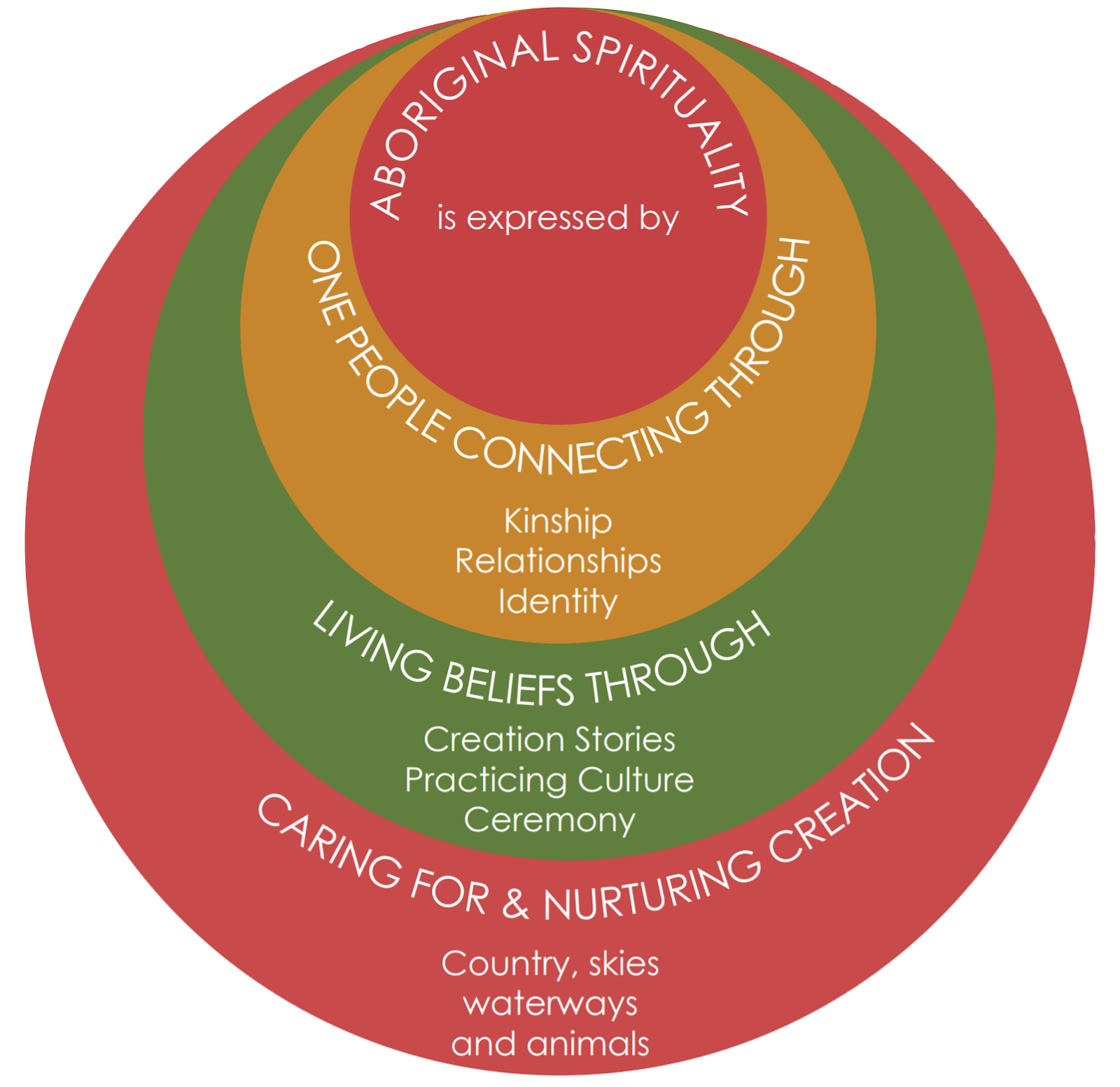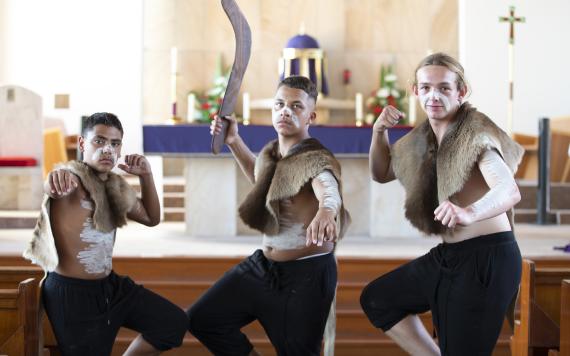Purpose
The Catholic Church is committed to the development of Aboriginal expressions of theology and spirituality. The Catholic Church also aims to promote and support a greater understanding of Aboriginal peoples, cultures and social justice issues amongst the wider community.
Pope John Paul II, in his famous message to the Aboriginal Peoples of Australia in Alice Springs 1986, stated that the Catholic Church will be lacking in its full expression if it does not embrace the spirituality of our Aboriginal people.
The Australian Bishops, in their 2019 Pastoral Letter, call for all Catholics to walk alongside Aboriginal and Torres Strait Islander people and to embrace “Aboriginal and Torres Strait Islander spirituality within the wider Catholic spirituality” as a means of deepening their own faith and furthering Reconciliation.
Catholic Schools NSW’s Aboriginal and Torres Strait Islander Reference Group has produced this resource to support Catholic school communities to give life to this aspiration.
How to use this resource
The following information has been compiled to assist school staff engage in meaningful ways with Aboriginal Spirituality to enrich the faith and cultural life of their students, staff and communities.
While this resource draws on the voices of Aboriginal and non-Aboriginal people who share their wisdom and insights from their own personal spiritual journeys, we encourage teachers to find other voices in their local communities to add richness to their understanding and experience of Aboriginal spirituality and in particular to discover how traditional rituals and symbols can be used in culturally appropriate ways within their school’s context.
When embedding Aboriginal Spirituality into the curriculum and experience of the school it is important that you do not rely solely on texts. Localising Aboriginal Spirituality will have more meaning for students and at the same time demonstrate the diversity of experiences of Aboriginal people and communities throughout NSW.
Teaching and learning resources
- There are Aboriginal Catholic Ministries in every State and Territory of Australia. These services can provide support in incorporating the gifts of Aboriginal culture, rituals and symbols into liturgy and the spiritual life of the school. Contact details for these ministries can be found at the NATSICC website.
- The National Aboriginal and Torres Strait Islander Catholic Council (NATSICC) is the peak advisory body to the Australian Catholic Bishops on issues relating to Aboriginal and Torres Strait Islander Catholics.
- Australian Bishops Conference Commission for Relations with Aboriginal and Torres Strait Islander Peoples.
- Stories and Voices: Personal stories that engage with Aboriginal Spirituality which enables the reader to gain understanding through another lens. A powerful part of hearing these stories is making your own meaning as a part of your formation and understanding of Aboriginal Spirituality in action.
Other useful resources:
- The Australian Dream - Civics and citizenship resources to help explore themes of cultural identity, history, racism and reconciliation.
- The Australian Institute of Aboriginal and Torres Strait Islander Studies - Resources to support Aboriginal and Torres Strait Islander knowledge and culture.
- First Languages Australia - First Nations Languages Map of Australia. This interactive map showcases over 780 Indigenous languages.
- National Library of Australia - The Library’s collection holds a diverse range of material, offering a rich interpretation of Australia’s past and contemporary Aboriginal culture.
- Australian Museum - Learn about the richness of First Nations cultures, histories and experiences.
What is Aboriginal spirituality?
All humans are spiritual beings with an innate desire to make meaning of the big questions of life. Our spirituality is about searching for meaning in life and reflecting on how we are in relationship with God, with other people, with the world around us, and with ourselves.
Parker J. Palmer defines spirituality as “…the ancient and abiding human quest for connectedness with something larger and more trustworthy than our egos…"
In Australia, Aboriginal and Torres Strait Islander peoples have been on this spiritual quest for over 65,000 years.
The word spirituality comes from the Latin word “spirare” which means to “breathe life into” and this meaning has particular resonance when exploring Aboriginal spirituality, which stems from a belief that the spirit of life is the result of a power greater than ourselves.
When we speak about Aboriginal spirituality it is important to note that there is not one common expression of this lived experience that can be found across Australia. Prior to 1788 our great south land housed hundreds of language and cultural groups who each had their own creation stories and spirituality so there is incredible diversity in the ways that Aboriginal and Torres Strait Islander peoples have and continue to express their spirituality.
However, within this diversity, there are some commonalities in Aboriginal spirituality that can be identified.
Aboriginal spirituality:
- acknowledges a Creator Spirit that was at the beginning of the Dreaming and is at the heart of all life
- recognises that Aboriginal people are spiritual people who are aware of the spiritual reality of the land and of their own lives and that land, language and identity are fundamental to knowing who you are, where you come from and what your place is
- involves the land and connection to country which demands a responsibility to care for and live in harmony with the land
- includes totemic relationships with birds, plants and animals that connect people to both the physical and the spiritual world, underpinning a reciprocal obligation to care for others and for the natural environment
- celebrates the sharing of stories and the passing down of stories from generation to generation.
What is not Aboriginal spirituality?
Many texts and books use ‘Aboriginal religion’ when addressing Aboriginal spirituality. But these two terms should not be confused:
- Spiritual “relates to people’s deepest thoughts and beliefs, rather than to their bodies and physical surroundings”.
- Religious is “something that […] is about or connected with religion”, i.e. “the belief in a God or Gods and the activities that are connected with this belief, such as prayer or worship in a church or temple”.
Hence spirituality is the foundation of religion, the deeper layer of any religious practice and expression.
Why should I embed Aboriginal spirituality?
Spirituality is a broad concept with room for many perspectives. People experience and express their spirituality for different reasons and in different ways.
Catholicism does not strive to take the place of Traditional Culture, rather it harbours a deep desire to be enriched by the gifts that the first Australians can bring. As Catholic educators, it is imperative for us to acknowledge Aboriginal Spirituality and recognise the rich cultural expertise and teachings of Aboriginal peoples in the teaching of our Catholic faith.
Stories throughout the Bible serve to teach about sharing and caring for each other and the land. It also serves to provide moral guidance. Similarly, traditional Aboriginal culture uses stories to serve the same purpose. Today, whilst there is still an acknowledgement of Aboriginal (and Torres Strait Islander) spiritual beliefs, there is little understanding of these beliefs or how they impact on lifestyles and behaviours. We can commit to celebrating and promoting awareness of Aboriginal culture by placing God’s teachings into Aboriginal cultural context. Once these connections are made, the Gospel is perfectly relevant and at the centre of the faith systems of Aboriginal and non-Aboriginal Catholics.
This diagram expresses a framework for Aboriginal Spirituality drawing from a holistic approach to develop formation or identity of self, family and community.

A call to act
“It is essential to show special care for indigenous communities and their cultural traditions. They are not merely one minority among others, but should be the principal dialogue partners, especially when large projects affecting their land are proposed. For them, land is not a commodity but rather a gift from God and from their ancestors who rest there, a sacred space with which they need to interact if they are to maintain their identity and values”.
Pope Francis, Laudato Si’, 2015, 146.
Pope John Paul II’s teachings
Pope John Paul II’s visit to Australia in 1986 and his address to Aboriginal people was pivotal in the journey of Aboriginal Catholics.
"Take heart from the fact that many of your languages are still spoken and that you still possess your ancient culture. You have kept your sense of brotherhood. If you stay closely united, you are like a tree standing in the middle of a bush-fire sweeping through the timber. The leaves are scorched and the tough bark is scarred and burned; but inside the tree the sap is still flowing, and under the ground the roots are still strong. Like that tree you have endured the flames, and you still have the power to be reborn. The time for this rebirth is now!"
Pope John Paul II reminds us …
“Your culture, which shows the lasting genius and dignity of your race, must not be allowed to disappear. Do not think that your gifts are worth so little that you should no longer bother to maintain them. Share them with each other and teach them to your children. Your songs, your stories, your paintings, your dances, your languages, must never be lost.”
